2015 NISSAN MURANO radio
[x] Cancel search: radioPage 308 of 424
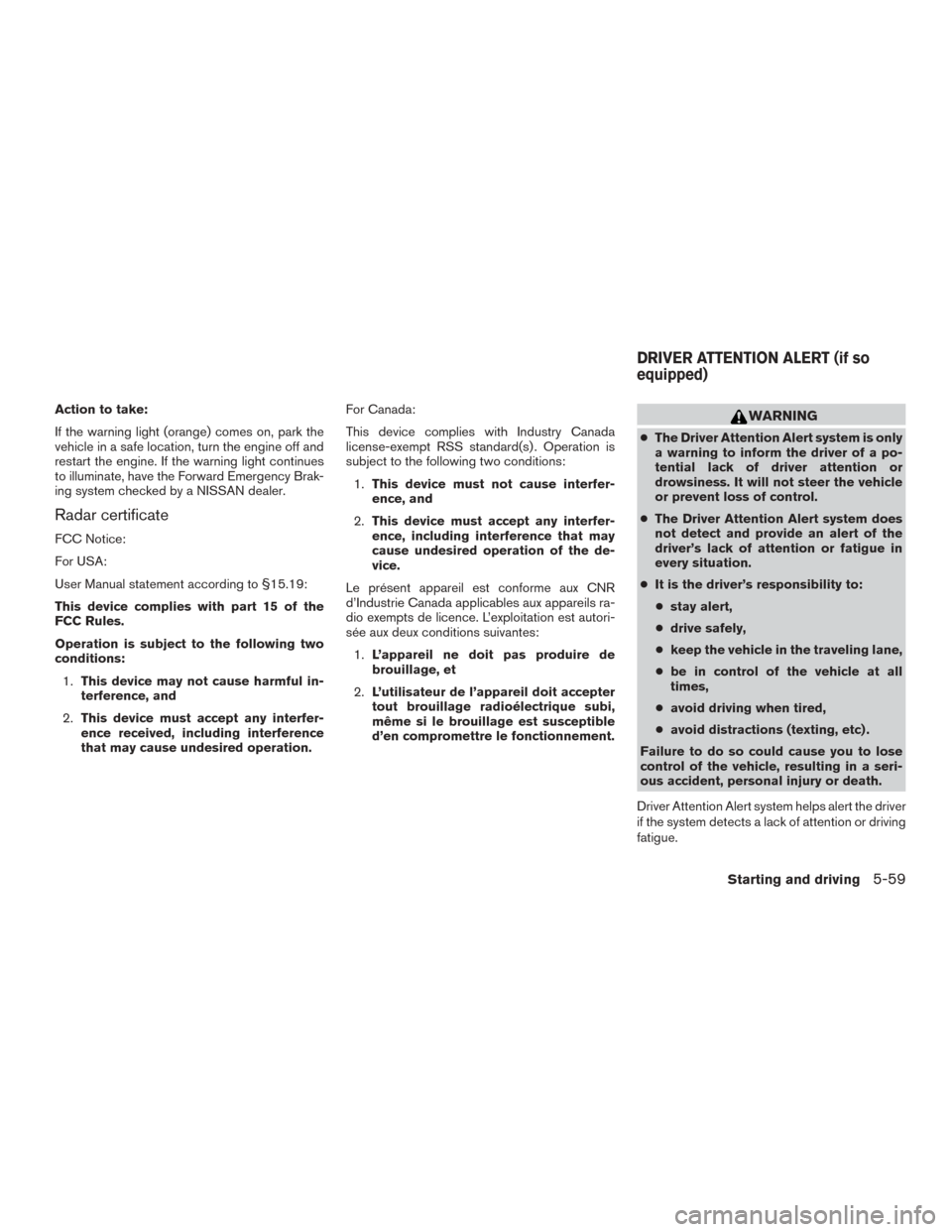
Action to take:
If the warning light (orange) comes on, park the
vehicle in a safe location, turn the engine off and
restart the engine. If the warning light continues
to illuminate, have the Forward Emergency Brak-
ing system checked by a NISSAN dealer.
Radar certificate
FCC Notice:
For USA:
User Manual statement according to §15.19:
This device complies with part 15 of the
FCC Rules.
Operation is subject to the following two
conditions:1. This device may not cause harmful in-
terference, and
2. This device must accept any interfer-
ence received, including interference
that may cause undesired operation. For Canada:
This device complies with Industry Canada
license-exempt RSS standard(s) . Operation is
subject to the following two conditions:
1. This device must not cause interfer-
ence, and
2. This device must accept any interfer-
ence, including interference that may
cause undesired operation of the de-
vice.
Le présent appareil est conforme aux CNR
d’Industrie Canada applicables aux appareils ra-
dio exempts de licence. L’exploitation est autori-
sée aux deux conditions suivantes: 1. L’appareil ne doit pas produire de
brouillage, et
2. L’utilisateur de l’appareil doit accepter
tout brouillage radioélectrique subi,
même si le brouillage est susceptible
d’en compromettre le fonctionnement.
WARNING
● The Driver Attention Alert system is only
a warning to inform the driver of a po-
tential lack of driver attention or
drowsiness. It will not steer the vehicle
or prevent loss of control.
● The Driver Attention Alert system does
not detect and provide an alert of the
driver’s lack of attention or fatigue in
every situation.
● It is the driver’s responsibility to:
● stay alert,
● drive safely,
● keep the vehicle in the traveling lane,
● be in control of the vehicle at all
times,
● avoid driving when tired,
● avoid distractions (texting, etc) .
Failure to do so could cause you to lose
control of the vehicle, resulting in a seri-
ous accident, personal injury or death.
Driver Attention Alert system helps alert the driver
if the system detects a lack of attention or driving
fatigue.
DRIVER ATTENTION ALERT (if so
equipped)
Starting and driving5-59
Page 326 of 424
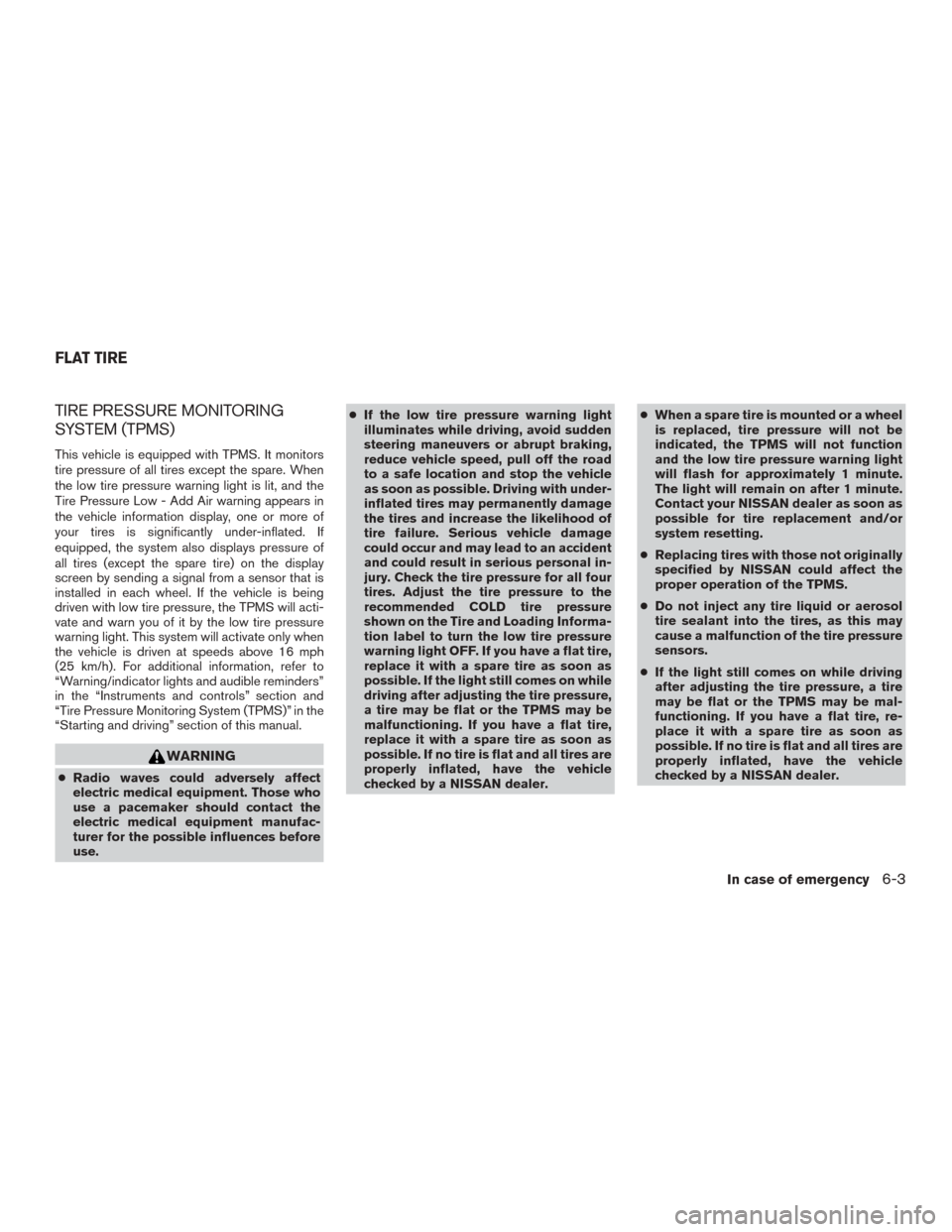
TIRE PRESSURE MONITORING
SYSTEM (TPMS)
This vehicle is equipped with TPMS. It monitors
tire pressure of all tires except the spare. When
the low tire pressure warning light is lit, and the
Tire Pressure Low - Add Air warning appears in
the vehicle information display, one or more of
your tires is significantly under-inflated. If
equipped, the system also displays pressure of
all tires (except the spare tire) on the display
screen by sending a signal from a sensor that is
installed in each wheel. If the vehicle is being
driven with low tire pressure, the TPMS will acti-
vate and warn you of it by the low tire pressure
warning light. This system will activate only when
the vehicle is driven at speeds above 16 mph
(25 km/h). For additional information, refer to
“Warning/indicator lights and audible reminders”
in the “Instruments and controls” section and
“Tire Pressure Monitoring System (TPMS)” in the
“Starting and driving” section of this manual.
WARNING
●Radio waves could adversely affect
electric medical equipment. Those who
use a pacemaker should contact the
electric medical equipment manufac-
turer for the possible influences before
use. ●
If the low tire pressure warning light
illuminates while driving, avoid sudden
steering maneuvers or abrupt braking,
reduce vehicle speed, pull off the road
to a safe location and stop the vehicle
as soon as possible. Driving with under-
inflated tires may permanently damage
the tires and increase the likelihood of
tire failure. Serious vehicle damage
could occur and may lead to an accident
and could result in serious personal in-
jury. Check the tire pressure for all four
tires. Adjust the tire pressure to the
recommended COLD tire pressure
shown on the Tire and Loading Informa-
tion label to turn the low tire pressure
warning light OFF. If you have a flat tire,
replace it with a spare tire as soon as
possible. If the light still comes on while
driving after adjusting the tire pressure,
a tire may be flat or the TPMS may be
malfunctioning. If you have a flat tire,
replace it with a spare tire as soon as
possible. If no tire is flat and all tires are
properly inflated, have the vehicle
checked by a NISSAN dealer. ●
When a spare tire is mounted or a wheel
is replaced, tire pressure will not be
indicated, the TPMS will not function
and the low tire pressure warning light
will flash for approximately 1 minute.
The light will remain on after 1 minute.
Contact your NISSAN dealer as soon as
possible for tire replacement and/or
system resetting.
● Replacing tires with those not originally
specified by NISSAN could affect the
proper operation of the TPMS.
● Do not inject any tire liquid or aerosol
tire sealant into the tires, as this may
cause a malfunction of the tire pressure
sensors.
● If the light still comes on while driving
after adjusting the tire pressure, a tire
may be flat or the TPMS may be mal-
functioning. If you have a flat tire, re-
place it with a spare tire as soon as
possible. If no tire is flat and all tires are
properly inflated, have the vehicle
checked by a NISSAN dealer.
FLAT TIRE
In case of emergency6-3
Page 342 of 424
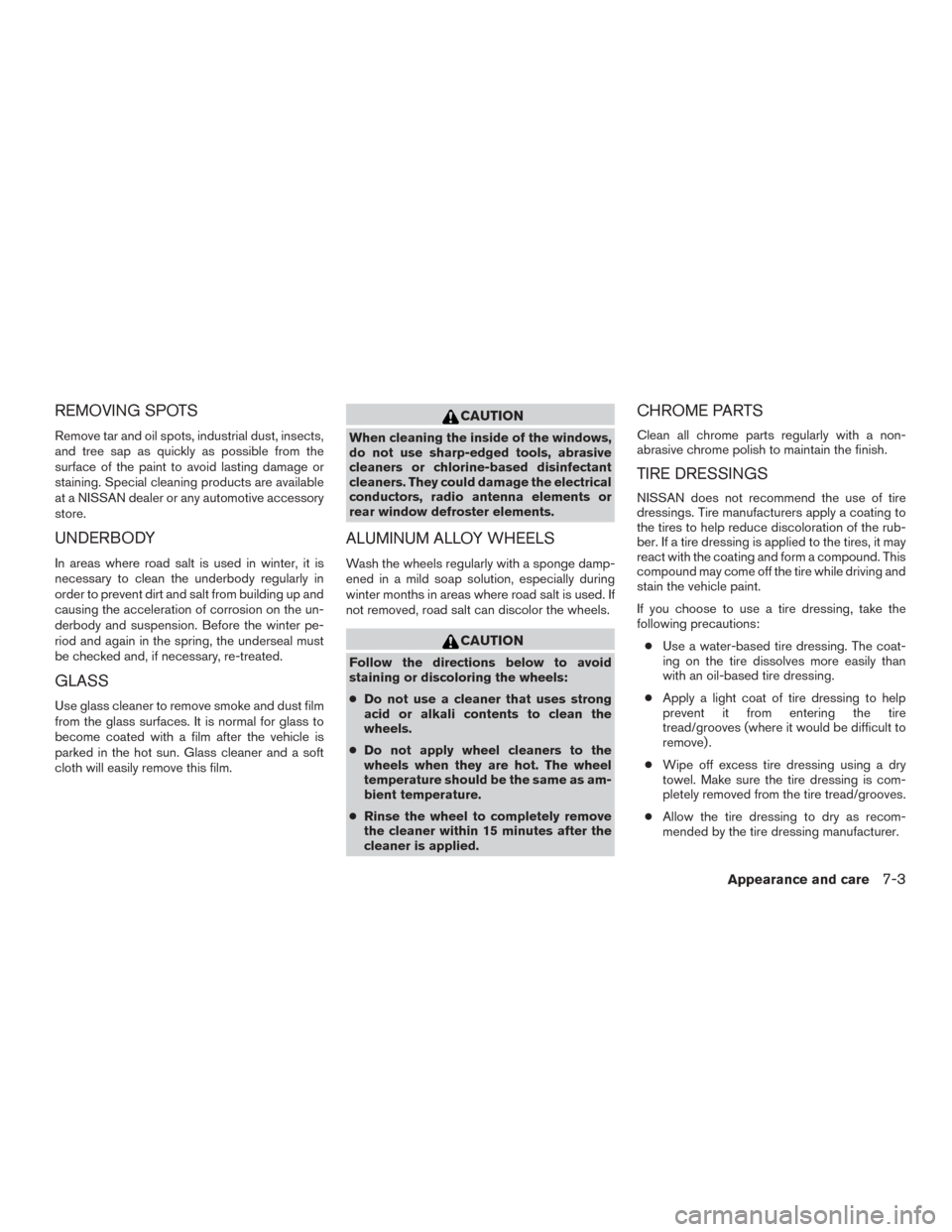
REMOVING SPOTS
Remove tar and oil spots, industrial dust, insects,
and tree sap as quickly as possible from the
surface of the paint to avoid lasting damage or
staining. Special cleaning products are available
at a NISSAN dealer or any automotive accessory
store.
UNDERBODY
In areas where road salt is used in winter, it is
necessary to clean the underbody regularly in
order to prevent dirt and salt from building up and
causing the acceleration of corrosion on the un-
derbody and suspension. Before the winter pe-
riod and again in the spring, the underseal must
be checked and, if necessary, re-treated.
GLASS
Use glass cleaner to remove smoke and dust film
from the glass surfaces. It is normal for glass to
become coated with a film after the vehicle is
parked in the hot sun. Glass cleaner and a soft
cloth will easily remove this film.
CAUTION
When cleaning the inside of the windows,
do not use sharp-edged tools, abrasive
cleaners or chlorine-based disinfectant
cleaners. They could damage the electrical
conductors, radio antenna elements or
rear window defroster elements.
ALUMINUM ALLOY WHEELS
Wash the wheels regularly with a sponge damp-
ened in a mild soap solution, especially during
winter months in areas where road salt is used. If
not removed, road salt can discolor the wheels.
CAUTION
Follow the directions below to avoid
staining or discoloring the wheels:
●Do not use a cleaner that uses strong
acid or alkali contents to clean the
wheels.
● Do not apply wheel cleaners to the
wheels when they are hot. The wheel
temperature should be the same as am-
bient temperature.
● Rinse the wheel to completely remove
the cleaner within 15 minutes after the
cleaner is applied.
CHROME PARTS
Clean all chrome parts regularly with a non-
abrasive chrome polish to maintain the finish.
TIRE DRESSINGS
NISSAN does not recommend the use of tire
dressings. Tire manufacturers apply a coating to
the tires to help reduce discoloration of the rub-
ber. If a tire dressing is applied to the tires, it may
react with the coating and form a compound. This
compound may come off the tire while driving and
stain the vehicle paint.
If you choose to use a tire dressing, take the
following precautions:
● Use a water-based tire dressing. The coat-
ing on the tire dissolves more easily than
with an oil-based tire dressing.
● Apply a light coat of tire dressing to help
prevent it from entering the tire
tread/grooves (where it would be difficult to
remove) .
● Wipe off excess tire dressing using a dry
towel. Make sure the tire dressing is com-
pletely removed from the tire tread/grooves.
● Allow the tire dressing to dry as recom-
mended by the tire dressing manufacturer.
Appearance and care7-3
Page 374 of 424

1. Map light
2 Headlight assembly
3 Personal light
4. Door mirror turn signal light
5. Fog light (if so equipped)
6. High mounted stoplight
7. License plate light
8. Rear combination light
9. Cargo light
10. Daytime running lightIf you have a flat tire, refer to the “In case of
emergency” section of this manual.
TIRE PRESSURE
Tire Pressure Monitoring System
(TPMS)
WARNING
Radio waves could adversely affect elec-
tric medical equipment. Those who use a
pacemaker should contact the electric
medical equipment manufacturer for the
possible influences before use.
This vehicle is equipped with the Tire Pressure
Monitoring System (TPMS) . It monitors tire pres-
sure of all tires except the spare. When the low
tire pressure warning light is lit and the Tire
Pressure Low - Add Air warning appears in the
vehicle information display, one or more of your
tires is significantly under-inflated. If equipped,
the system also displays pressure of all tires
(except the spare tire) on the display screen by
sending a signal from a sensor that is installed in
each wheel.
The TPMS will activate only when the vehicle is
driven at speeds above 16 MPH (25 km/h). Also,
this system may not detect a sudden drop in tire
pressure (for example a flat tire while driving) .
LDI2638
WHEELS AND TIRES
Maintenance and do-it-yourself8-29
Page 416 of 424
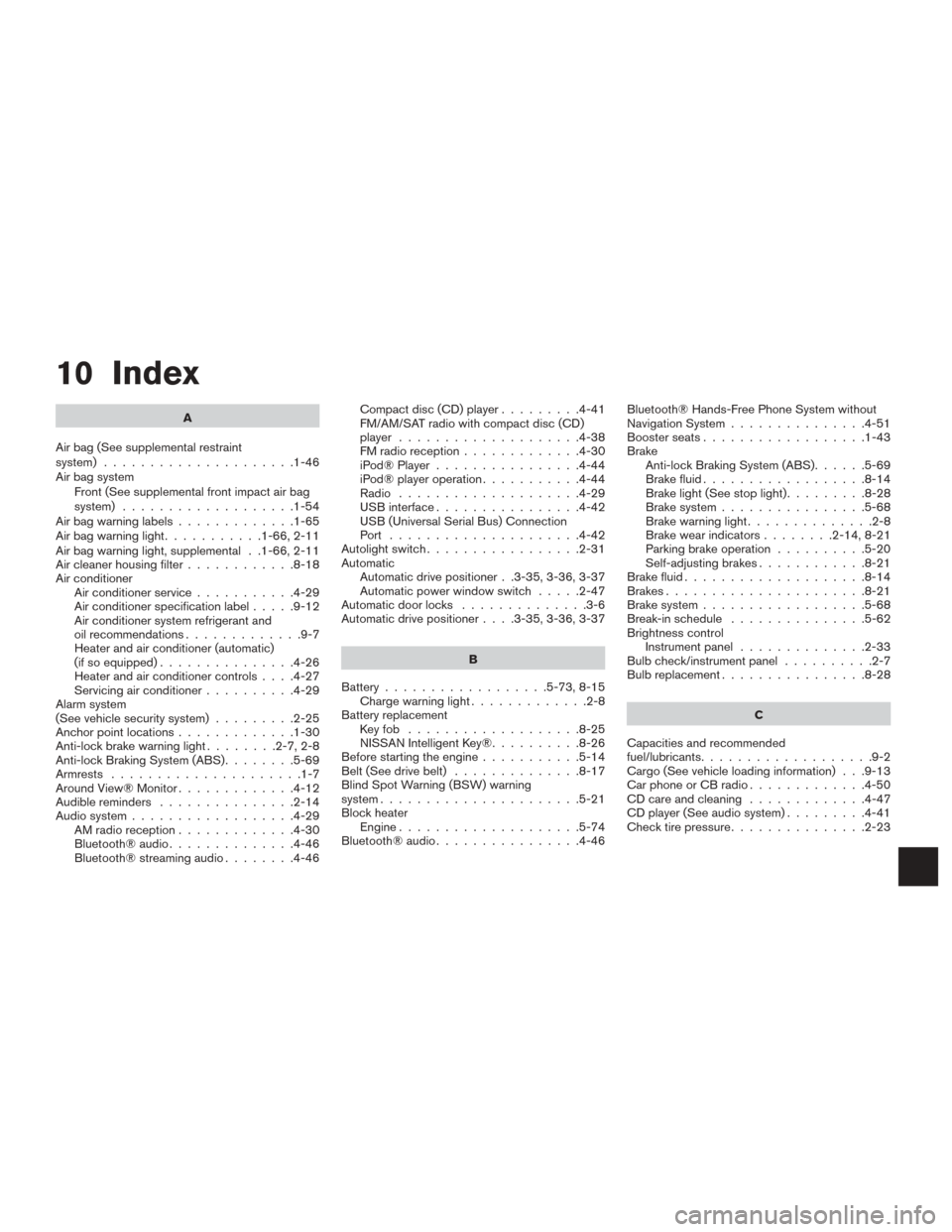
10 Index
A
Air bag (See supplemental restraint
system) .....................1-46
Air bag system Front (See supplemental front impact air bag
system) ...................1-54
Airbagwarninglabels.............1-65
Airbagwarninglight...........1-66,2-11
Air bag warning light, supplemental . .1-66, 2-11
Air cleaner housing filter ............8-18
Air conditioner Air conditioner service ...........4-29
Air conditioner specification label .....9-12
Air conditioner system refrigerant and
oil recommendations .............9-7
Heater and air conditioner (automatic)
(if so equipped) ...............4-26
Heater and air conditioner controls ....4-27
Servicing air conditioner ..........4-29
Alarm system
(See vehicle security system) .........2-25
Anchor point locations .............1-30
Anti-lock brake warning light ........2-7,2-8
Anti-lock Braking System (ABS) ........5-69
Armrests .....................1-7
Around View® Monitor .............4-12
Audible reminders ...............2-14
Audio system ..................4-29
AM radio reception .............4-30
Bluetooth®audio..............4-46
Bluetooth® streaming audio ........4-46Compact disc (CD) player
.........4-41
FM/AM/SAT radio with compact disc (CD)
player ....................4-38
FMradioreception.............4-30
iPod® Player ................4-44
iPod® player operation ...........4-44
Radio ....................4-29
USB interface ................4-42
USB (Universal Serial Bus) Connection
Port .....................4-42
Autolight switch .................2-31
Automatic Automatic drive positioner . .3-35, 3-36, 3-37
Automatic power window switch .....2-47
Automatic door locks ..............3-6
Automatic drive positioner ....3-35,3-36,3-37
B
Battery ..................5-73,8-15
Chargewarninglight.............2-8
Battery replacement Keyfob ...................8-25
NISSAN Intelligent Key® ..........8-26
Before starting the engine ...........5-14
Belt (See drive belt) ..............8-17
Blind Spot Warning (BSW) warning
system ......................5-21
Block heater Engine ....................5-74
Bluetooth®audio................4-46 Bluetooth® Hands-Free Phone System without
Navigation System
...............4-51
Boosterseats..................1-43
Brake Anti-lock Braking System (ABS) ......5-69
Brake fluid ..................8-14
Brakelight(Seestoplight).........8-28
Brake system ................5-68
Brakewarninglight..............2-8
Brakewearindicators........2-14,8-21
Parking brake operation ..........5-20
Self-adjusting brakes ............8-21
Brake fluid ....................8-14
Brakes ......................8-21
Brake system ..................5-68
Break-inschedule ...............5-62
Brightness control Instrument panel ..............2-33
Bulb check/instrument panel ..........2-7
Bulbreplacement................8-28
C
Capacities and recommended
fuel/lubricants ...................9-2
Cargo
(See vehicle loading information) . . .9-13
Car phone or CB radio .............4-50
CDcareandcleaning .............4-47
CD player (See audio system) .........4-41
Check tire pressure ...............2-23
Page 420 of 424
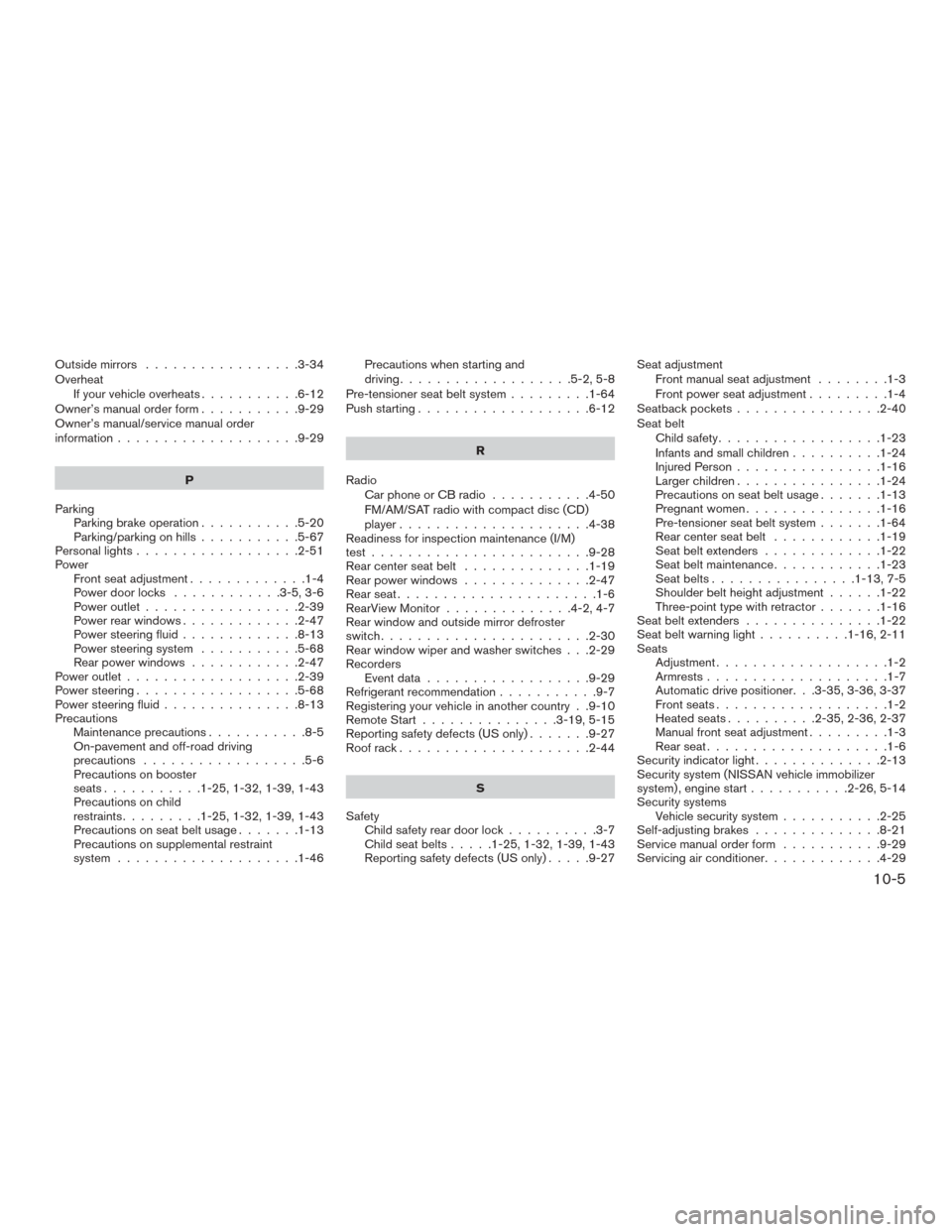
Outside mirrors.................3-34
Overheat Ifyourvehicleoverheats...........6-12
Owner’s manual order form ...........9-29
Owner’s manual/service manual order
information ....................9-29
P
Parking Parking brake operation ...........5-20
Parking/parking on hills ...........5-67
Personallights..................2-51
Power Front seat adjustment .............1-4
Power door locks ............3-5,3-6
Power outlet .................2-39
Power rear windows .............2-47
Power steering fluid .............8-13
Power steering system ...........5-68
Rear power windows ............2-47
Power outlet ...................2-39
Power steering ..................5-68
Power steering fluid ...............8-13
Precautions Maintenance precautions ...........8-5
On-pavement and off-road driving
precautions ..................5-6
Precautions on booster
seats...........1-25,1-32,1-39,1-43
Precautions on child
restraints .........1-25,1-32,1-39,1-43
Precautionsonseatbeltusage.......1-13
Precautions on supplemental restraint
system ....................1-46 Precautions when starting and
driving
...................5-2,5-8
Pre-tensioner seat belt system .........1-64
Push starting ...................6-12
R
Radio Car phone or CB radio ...........4-50
FM/AM/SAT radio with compact disc (CD)
player .....................4-38
Readiness for inspection maintenance (I/M)
test........................9-28
Rear center seat belt ..............1-19
Rear power windows ..............2-47
Rearseat......................1-6
RearView Monitor ..............4-2,4-7
Rear window and outside mirror defroster
switch .......................2-30
Rear window wiper and washer switches . . .2-29
Recorders Eventdata..................9-29
Refrigerant recommendation ...........9-7
Registering your vehicle in another country . .9-10
Remote Start ...............3-19,5-15
Reporting safety defects (US only) .......9-27
Roof rack .....................2-44
S
Safety Child safety rear door lock ..........3-7
Child seat belts .....1-25,1-32,1-39,1-43
Reporting safety defects (US only) .....9-27Seat adjustment
Front manual seat adjustment ........1-3
Front power seat adjustment .........1-4
Seatbackpockets................2-40
Seat belt Child safety ..................1-23
Infants and small children ..........1-24
Injured Person ................1-16
Largerchildren................1-24
Precautions on seat belt usage .......1-13
Pregnant women ...............1-16
Pre-tensioner seat belt system .......1-64
Rear center seat belt ............1-19
Seatbeltextenders .............1-22
Seatbeltmaintenance............1-23
S
eatbelts................1-13,7-5
Shoulder belt height adjustment ......1-22
Three-point type with retractor .......1-16
Seat belt extenders ...............1-22
Seatbeltwarninglight..........1-16,2-11
Seats Adjustment ...................1-2
Armrests....................1-7
Automatic drive positioner. . .3-35, 3-36, 3-37
Frontseats...................1-2
Heatedseats..........2-35, 2-36, 2-37
Manualfrontseatadjustment.........1-3
Rearseat....................1-6
Security indicator light ..............2-13
Security system (NISSAN vehicle immobilizer
system) , engine start ...........2-26,5-14
Security systems Vehicle security system ...........2-25
Self-adjusting brakes ..............8-21
Service manual order form ...........9-29
Servicing air conditioner .............4-29
10-5